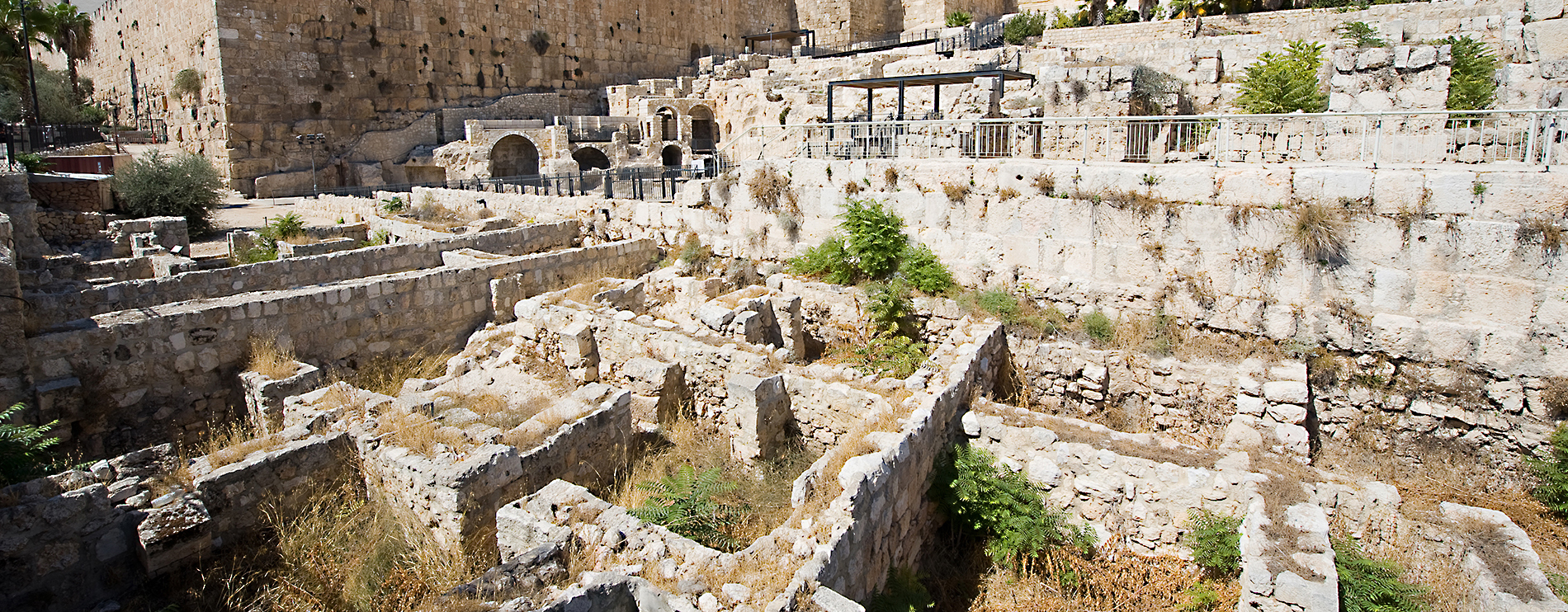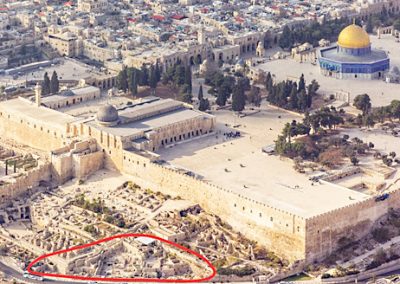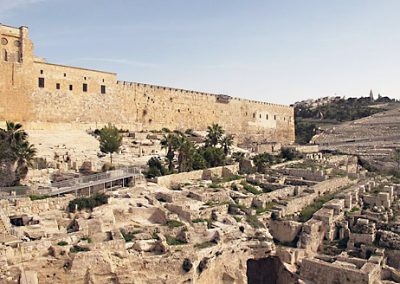
Bible, History, Archaeology
Bible,
History,
Archaeology
A seal of King Hezekiah,
son of Ahaz
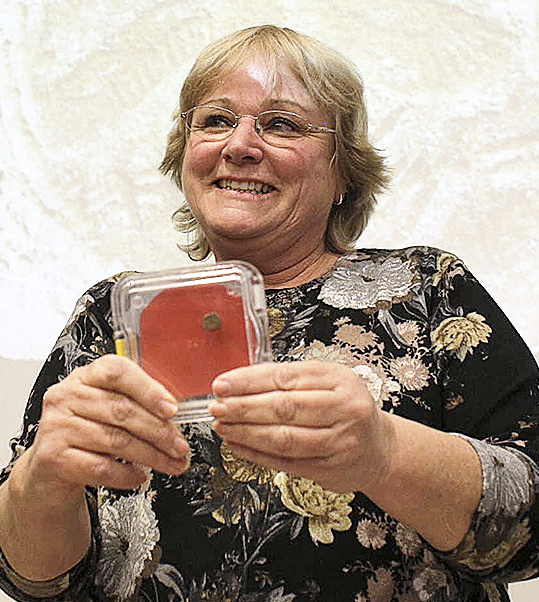
Image opposite: Eilat Mazar presents the Hezekiah seal to the press. Public domain.
The discovery

Image opposite: the seal with its three registers. © Eilat Mazar, photography by Ouria Tadmor.
From the earliest times, documents were written on clay tablets, and the seal was simply affixed at the end of the text, like a signature at the bottom of a letter. The use of clay tablets was common in Mesopotamia and extended as far as Egypt. Seals were usually cylindrical in shape, and the seal was unrolled onto the tablet to transfer the design.
But the seal whose imprint was discovered in Jerusalem is of a different type: it's an oval-shaped seal, probably set in a ring and applied like a stamp. The documents thus authenticated were not cuneiform tablets, but rolls of papyrus or parchment, wrapped with a knotted string and then sealed with a clay bubble that was stamped with the seal. Traces of the original papyrus are still visible on the reverse side of the bulla.
The seal inscription

 Image opposite: a reconstruction drawing of the hieroglyphic signs and Palaeohebraic letters on the seal impression. Courtesy of Robert Deutsch.
Image opposite: a reconstruction drawing of the hieroglyphic signs and Palaeohebraic letters on the seal impression. Courtesy of Robert Deutsch.
The use of Paleo-Hebrew letters dates back to the 10th/9th century BC.
Asians« (Semites) borrowed Egyptian hieroglyphs and transformed them into alphabetic signs. The oldest known example of this is the script known to scientists as »protosinaitic«. Alphabetic writing developed slowly over the centuries, gradually giving rise to more than a dozen different alphabets represented on the shores of the Mediterranean: Phoenician, Aramaic, Hebrew, Greek, Latin... The alphabetic system is a veritable revolution, as it makes writing simpler and faster.
Seal motifs
The central register of the cachet features two figures, curiously taken straight from Egyptian mythology: an annealed cross, called the ânkh, which represents life in Egyptian hieroglyphics, and a sun at its zenith, surrounded by rays and endowed with two broad wings spread out as a sign of protection. This image normally represents one of the main Egyptian deities, the solar god Ra («the one who makes»), later associated with Atum, the solar creator god. So what do these Egyptian motifs have to do with King Hezekiah's seal? Since the second millennium B.C., the Levant had been under the influence of the powerful Egyptian empire, with its civilization and culture spreading everywhere.
 Image opposite: translation of Paleo-Hebrew characters and hieroglyphic motifs. Courtesy of Robert Deutsch.
Image opposite: translation of Paleo-Hebrew characters and hieroglyphic motifs. Courtesy of Robert Deutsch.
This Hezekiah seal impression is not unique. In 1986, an imprint of a seal with exactly the same inscription and motifs was discovered, dated to around 728-699 B.C. But its unknown provenance - it had not been uncovered as part of a regular archaeological excavation - meant that no conclusions could be drawn. 1. In fact, there are several seal impressions bearing the inscription : «Belonging to Hezekiah, (son of) Ahaz, king of Judah » 2.
The discovery of this bulla confirms the historical existence of King Hezekiah of Judah. This time, we have a royal inscription whose provenance is attested. It adds to the growing body of archaeological data demonstrating the reliability of the historical framework of the biblical accounts for the period of the kingdoms of Israel and Judah.
1 - Robert Deutsch, Lasting Inscriptions. magazine Biblical Archaeology Review 28/4, 2002: 42-51; Graves 2015: 132-133.
2 - L. J. Mykytiuk, Identifying Biblical Persons in Northwest Semitic Inscriptions of 1200-539 B.C.E. Society of Biblical Lit, 2004 : 221-223.
The reign of Hezekiah
The translation of the Paleo-Hebrew inscription of this Jerusalem bull, published by E. Mazar, reads: «To Hezekiah, (son of) Ahaz, king of Judah ». King Hezekiah is mentioned in the Bible from the Second Book of Kings (16, 20) : «Ahaz slept with his fathers and was buried with his fathers in the city of David. Hezekiah, his son, reigned in his place.». According to biblical historians, Hezekiah must have reigned over the kingdom of Judah from about 728 to 699 B.C. There was a co-regency of about two years before Hezekiah. the death of Ahaz.
The Bible describes Hezekiah as a religious reformer who re-established the order of worship in the Jerusalem Temple. He is assisted in his task by the prophet Isaiah.
Hezekiah, anticipating a siege of Jerusalem, extended the fortified city walls and dug a tunnel from the Guihon spring to the Siloé reservoir (533 m). Today it is known as the Hezekiah Tunnel and is used to supply water (2 Chronicles 32,2-4 ; 2 Kings 20,20).
Image opposite: the inscription on the left-hand side reads: «Sennacherib, the mighty king, king of the land of Assyria, seated on the throne of judgment, before (or at the entrance to) the city of Lachish. I give permission to slay him». Bas-relief of Nineveh Palace (detail). © oncenawhile.
On the death of Sargon II (705 BC), his son Sennacherib ascended the throne, and uprisings began. But Sennacherib, in a campaign to the west, subdued Phoenicia (701BC). Ammon, Edom and Moab pay tribute. Hezekiah, leader of the rebels, submitted after the capture of Lachish (2 Kings 18,31); he, in turn, was forced to pay a heavy tribute. Later, during a new rebellion by the Philistines and Egypt, Sennacherib laid siege to Jerusalem (-690), but his army was decimated by a disease that may have been a form of plague (2 Kings 19,35-36).
The ruins of Ophel today (detail). A hill between the City of David and the Temple esplanade, where the bull of Hezekiah was unearthed. © Robert Hoetink 243533794.
Eilat Mazar presents the Hezekiah seal to the press © Eilat Mazar.
Eilat Mazar in his presentation to the press of the Hezekiah seal.
General view of the Ophel in the City of David. Public domain.
General view of the Ophel in the City of David.

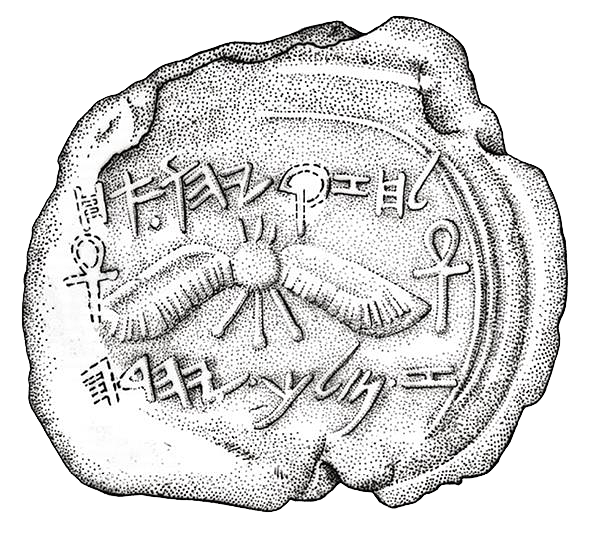 Image opposite: a reconstruction drawing of the hieroglyphic signs and Palaeohebraic letters on the seal impression. Courtesy of Robert Deutsch.
Image opposite: a reconstruction drawing of the hieroglyphic signs and Palaeohebraic letters on the seal impression. Courtesy of Robert Deutsch.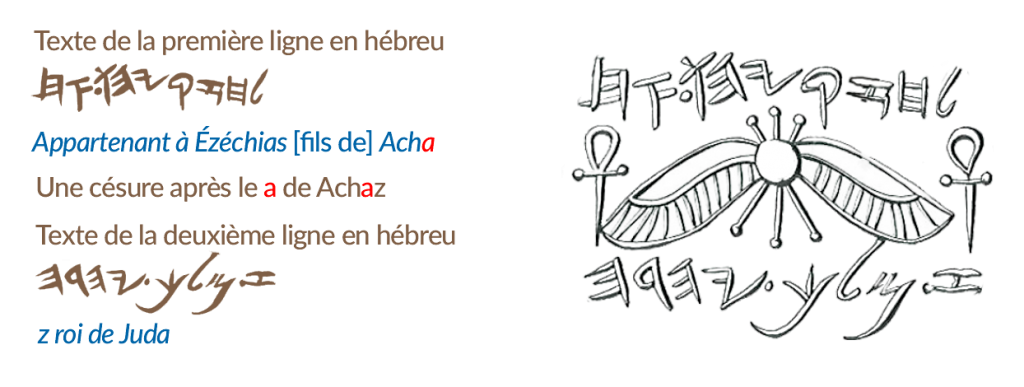 Image opposite: translation of Paleo-Hebrew characters and hieroglyphic motifs. Courtesy of Robert Deutsch.
Image opposite: translation of Paleo-Hebrew characters and hieroglyphic motifs. Courtesy of Robert Deutsch.